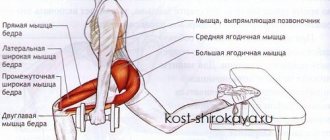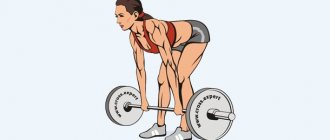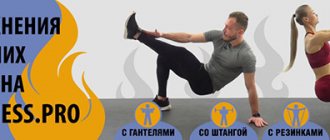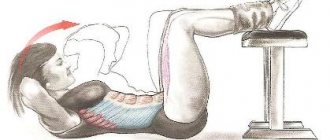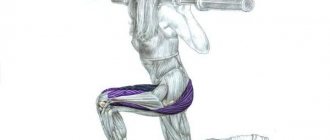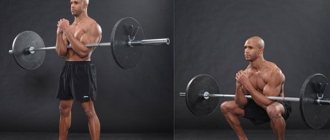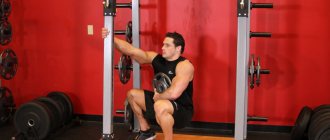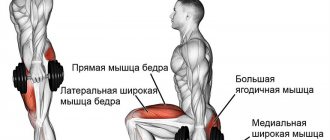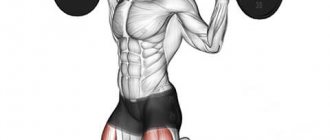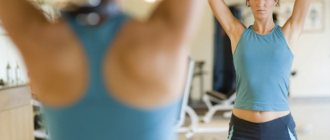An effective exercise that has a large number of advantages and is relevant for people of different ages and genders is squats with dumbbells. It does not require special equipment, so it can be performed at home, on the street and in the gym. The correct technique for performing squats with a load will help tone the body, make the muscles more resilient, and the body fit and slender. Read the article about how to squat with dumbbells correctly so as not to cause harm to the body, as well as the benefits of squats with dumbbells for the buttocks and thighs.
Benefits of squats
Training using dumbbells has remained in demand for many years. Unlike exercises with a barbell, the spine is less loaded during exercises with dumbbells, which is an undeniable advantage for people with back problems.
Here are just a few points that speak about the benefits of squats with dumbbells:
- Almost all muscles are involved, due to which the silhouette becomes toned and more attractive.
- Exercise helps you fight excess weight by gaining muscle mass.
- Exercises for the buttocks and thighs tone the muscle tissue, making it elastic. Due to this, the risk of injury or sprains is reduced.
- It has a positive effect on posture.
- Constant training increases endurance and helps improve overall physical condition.
Squats will help you quickly form an attractive figure, even if you are overweight.
About the benefits
For girls, squats with dumbbells for the buttocks are the main exercise aimed at working the gluteal muscles and three groups of thigh muscles (posterior, anterior, medial).
Any girl, having understood how to squat correctly, will appreciate all the benefits of this seemingly simple exercise:
- leg muscles develop;
- thanks to the additional load in the exercise, the maximum number of muscles of the back, abdomen, and legs are involved;
- the girl’s (woman’s) movements become more coordinated;
- the flexibility of the joints significantly increases;
- more calories are consumed;
- women and girls note an improvement in hormonal levels;
- when performing the exercise, the spine does not feel much load;
- the entire load goes entirely to the legs, bypassing the back;
- metabolism improves.
Squatting with weights means using a lot of muscles. First of all, deep squats with weights work on:
- gluteus maximus muscle;
- muscles located on the thighs (quadriceps, biceps);
- all thigh muscles included in the adductor group of muscle fibers;
- biceps muscle (gastrocnemius).
A good load on the shoulder girdle and arm muscles is achieved through weights. The abdominal and back muscles work actively.
Benefits of Exercise
Regular exercise with dumbbells has a number of advantages:
- complex effect on the muscles of the body;
- enhanced development and strengthening of leg muscles;
- development of elasticity of tendons and ligaments;
- moderate load on the back and spine;
- development of joint plasticity;
- uniform distribution of load throughout the body;
- increased energy expenditure and calorie burning;
- development of the core muscles, which are responsible for the stabilization and balance of the muscles of the spine, pelvis, hips and abdomen.
Basic technique for glute squats with dumbbells
- The stance of the legs can be narrow or wide. In a narrow position of the legs, in addition to the buttocks and back extensors, the front surface of the thigh (quadriceps) is significantly trained, which is not very good for women. In a wide stance, the same muscles are involved, only the load is transferred from the quadriceps to the back of the thigh (biceps). In a very wide position - “plie” - the load is greatly shifted to the inner surface of the thighs (adductor muscle), which is also not the best option for girls.
- The toes are turned 45 degrees and point in the same direction as the knees.
- A correct squat is performed by moving the hip joint back.
- The knees should not be brought together, spread apart or pulled out over the toes.
- The emphasis is on the heels and the outer surface of the foot. If you put the load on your toes, you will fall forward, and this will lead to injury.
- As you lower, inhale, and at the end of the effort, exhale.
- The deeper the squat, the more the gluteal muscle will be involved in the work (dumbbells should not touch the floor).
- The upward movement of the body occurs with the force of the buttocks.
- There is no rest phase at the top point, and the knees remain slightly bent to maintain the load in the gluteal muscles.
- The back is always naturally arched. Under no circumstances should you hunch over. It’s easy to keep it straight if you look in front of you at the top far corner while doing the exercise.
- You cannot lean forward too much, otherwise the squat will turn into a deadlift.
- The back cannot be rounded in the lower phase. Pelvic drop can occur due to weak spinal erectors, dumbbells that are too heavy, or a lack of natural body tilt.
Warm-up
Before you start performing the main set of exercises, you need to warm up. Warming up will prepare the body for more serious loads, and will also increase blood flow to the muscles and joints.
First of all, stretch your legs. It is necessary to prepare and warm up the joints, especially the knees. This will help eliminate the risk of injury when moving on to the main series of exercises.
- Simple bends: Straighten your legs and place them shoulder-width apart. Bend towards your feet one at a time. Pause near each leg until you feel tension in each muscle. Take your starting position. For each leg we do 30 repetitions.
- Tilt-twisting: legs are shoulder-width apart, arms are clasped and raised above the head. We turn the body to the left and tilt first to the left, then to the right leg. We take the starting position and repeat the exercise, starting from the right side.
- Hip rotation: hands on hips, feet shoulder-width apart. We begin to perform smooth rotational movements in a circle. 20 rotations each on the left and right sides.
- Warm up your knees: bring your legs together and slightly bend your knees, place your palms on them and begin to perform wide rotational movements for 2 minutes in one direction, then the same in the other direction.
Warm-up should take at least 10 minutes.
Thanks to better functioning of blood vessels in the pelvic area, you can normalize metabolism, tighten the skin and improve its general condition.
Technique for performing squats with a barbell
- Place the bar in a special power frame at shoulder level. Approach the bar with your back, placing the bar on the upper part of the trapezius, in no case do not place the weight on the cervical vertebrae;
- After removing the barbell from the racks, take a couple of steps back, placing your feet pelvis-width apart. Socks are parallel to each other, or slightly apart. The chin is slightly raised so that you can look up;
- Inhale: slowly squat, lowering your hips horizontally. The knees form an angle of 90 degrees, and the knees should not go beyond the toes, as this will injure the knee joint. The gaze is directed upward, the back is straight, the shoulder blades are brought together. Elbows point slightly back.
Remember! The lower back is not rounded and the body does not lean forward too much. We stretch our tailbone back - this is mandatory when performing the technique for the growth of the gluteal muscles, this increases the stretching of the muscle.
- Exhale: using more force from the gluteal muscles, we perform a faster rise, straightening the knees and straightening the torso. When returning to the starting position, it is advisable not to straighten your knees completely in order to relieve the load on your knees.
Differences between exercises for women and men
As a rule, men are more resilient and have greater physical strength than women. Therefore, exercises for people of different sexes always have certain differences. Men, first of all, want to have a pumped up body, so they choose heavy loads to gain muscle mass. Women most often want to pump up their butts and make their silhouette more slender and sculpted. This does not require heavy weights and for this purpose it is not necessary to visit the gym, but it will be enough to choose dumbbells weighing up to 5 kg.
Features of their use
Before we talk about the types of squats with dumbbells, as well as the correct technique, here are some general nuances:
- If your goal is to target the inner thigh muscles, stand with your feet wider than shoulder-width apart and turn your toes out more than 45 degrees;
- If you are trying to pump up your buttocks, squat as deep as possible;
- If you want to pay attention to the outer thighs, place your feet parallel and close to each other;
- In order for the hamstrings to work, you should tilt your body forward in a squat and move your pelvis back;
- During any squats, keep your back straight without rounding your spine;
- In all exercises, you should ensure that your heels do not leave the floor. The exception is at the top of the lift - here you can rise on your toes to engage the calf muscles.
Types of squats with dumbbells
There are several types of squats, differing from each other in the technique of execution. However, there is a universal scheme that will help you perform squats correctly:
- always keep your body straight;
- dumbbells are most often held in the hands;
- feet pressed tightly to the floor;
- slowly squat, moving the body weight onto the feet;
- once the dumbbells reach your ankles and your thighs are parallel to the floor, hold for a few seconds;
- the pelvis is retracted;
- You need to do a squat while inhaling, and rise while exhaling;
- The knees should be kept bent, so the muscles will feel the load more.
Plie squats with dumbbells
This type maximizes the use of the back of the thigh. The technique for performing a plie squat is quite simple:
- in the starting position, legs are shoulder-width apart, looking ahead;
- feet placed to the side;
- clasp the dumbbell with your hands;
- smoothly lower down, continuing to keep your body straight;
- knees should remain within the toes of the feet;
- return to the starting position.
- do 20 approaches.
Squats with dumbbells should not be performed if you have problems with the spine, scoliosis, varicose veins, hernia, sciatica or hypertension.
Bulgarian squats
The exercise has another name - split squats. To perform the Bulgarian squat, you need a platform or any other surface that is knee-high. To work each muscle more thoroughly and effectively, you should train each leg in turn. Attention to correct execution:
- turn your back to the platform, moving some distance away from it. Place your right leg on a support, and put your left leg forward, slightly bending at the knee;
- pick up dumbbells;
- straighten your body and begin to slowly lower down;
- as soon as the thigh and sports equipment become parallel to the floor, you need to pause;
- the knee of the hind leg does not touch the floor and forms a right angle;
- return to the original position.
- do 20 repetitions for the left and right legs.
If you have just started pumping your hips and buttocks, try doing a few workouts without weights. You need to learn technique and balance.
Squats with dumbbells on shoulders
In fact, these squats differ from traditional squats with dumbbells in hands only in the location of the apparatus, which in this case is located on the shoulders. If there is the slightest discomfort, you can place a towel or something soft under your shoulders. The correct way to perform shoulder squats is to ensure that your shoulders and torso always remain straight and your elbows are not raised too high.
Deep squats with dumbbells in hands
This type of squat is considered a more serious test that loads the lower limbs. It is better to move on to performing such exercises for the buttocks with a certain level of training.
- clasp the dumbbell with both hands and lift it to chest level;
- the feet are spaced slightly wider than the shoulders and slightly turned outward;
- slowly bend down, pushing your hips back and bending your knees slightly;
- hold this position for a while and slowly raise your body;
- perform 20 repetitions.
Exercises are of no use if you do them incorrectly. Some mistakes in training can only harm your figure, not improve it.
Single leg dumbbell squats
This exercise should be chosen by those who want to work the gluteal muscles and the anterior quadriceps femoris muscle.
- Move your pelvis back as much as possible, and do not tilt your body forward too much;
- put one leg forward, take the other back;
- dumbbells are in the hands;
- smoothly begin to squat;
- knees are slightly bent and do not go beyond the line of the toes;
- As soon as the knee of the back leg lightly touches the floor, pause;
- back straight;
- after a few seconds, return to the starting position;
- Do 20 sets on each leg.
The main muscles involved in performing squats with dumbbells are the gluteus maximus and quadriceps.
Overhead dumbbell squats
Performing squats with one arm raised up, the benefits of the exercise are the development of a sense of balance and alternate load on the right and left arms, as well as on the abdominal and back muscles.
- keep your back straight and your head straight, bend your knees slightly;
- We take the dumbbell in our hand and raise it above our head;
- keep your hips tense;
- lower yourself smoothly until your thighs are parallel to the floor;
- while exhaling, take the starting position;
- alternate the load, placing the projectile first in your left hand, then in your right hand.
The gluteal muscles are actively involved in straightening the body, moving the hips back and to the side.
Scissor squats with dumbbells
A universal exercise, it is popular among athletes of different ages and body types. The technique is quite simple:
- legs are straightened, dumbbells are in hands, slightly bent at the elbows;
- lunge wide forward, back foot on the toe, front foot completely resting on the floor;
- squat down smoothly, paying attention to your knees: the front should not extend beyond the toes, and the back should not touch the floor;
- as soon as the thigh becomes parallel to the floor, as you exhale, quickly raise your pelvis, maintaining body support on the heel of your front foot;
- For each leg, perform 20 approaches.
Without a deep squat, the glutes are not engaged. Usually the problem is that the hip joint is not flexible enough. Perform hamstring stretches.
Technique
When performing squats with dumbbells for the buttocks, girls actively load their legs. The same exercise, performed in different ways, makes it possible to pump up the buttocks in one version and the thighs in another. Rules that must be followed during training:
- Squats with weights should be preceded by a short warm-up.
- When performing exercises, do not slouch, keep your back straight. The natural curve of the lower back is acceptable during execution.
- When performing a squat, do not bring your knees together.
- To better work the gluteal muscle, when rising to a vertical position, do not straighten your knees.
- While moving, do not lower your head down - this leads to poor breathing; always keep your head straight.
- Inhale as you squat, exhale as you rise.
- Dumbbell weight 5 kg is the permitted weight for women and girls.
- Alternate approaches with 2 minute periods of quiet rest.
- A girl's standard workout can include from 3 to 5 approaches. One full approach is a minimum of 15, maximum of 30 repetitions of the exercise.
Brief description of the classic squat technique
You need to take a dumbbell in each hand, straighten up, lower your arms together with the dumbbells freely down (along the body), put your legs at shoulder level, do not tilt your head, in the lower back, while maintaining a natural bend.
Taking a deep breath, squat slowly, keeping your knees at a right angle at the bottom point. In the lower position, it is important to keep your thighs parallel to the floor line. At this time, both dumbbells should be in the ankle area. Throughout the entire exercise, it is important to feel the tone of the muscles of the back, legs, and buttocks. You need to stay in the lower position for 2 seconds. When finishing the squat, you need to exhale slowly and straighten up.
How to avoid getting injured
To avoid any injuries, it is important to follow a few simple rules:
- Remember to always warm up.
- Select the weight of the dumbbell according to your level of training.
- Follow the correct technique for doing the exercises.
- Pay special attention to breathing.
- Avoid sudden movements and perform exercises slowly.
- Listen to your body, exercise shouldn't hurt.
Common Mistakes
Lack of equipment and disregard for the rules often leads to injury. There is a list of the main mistakes that not only beginners, but also experienced athletes make:
- excessive arching of the back. A slightly concave position of the back is considered correct;
- Excessive tilt of the body forward puts a lot of stress on the back and spine, while reducing the load on the buttocks and hips;
- mobility of heels and feet. They must remain still at all times;
- your knees should remain bent.
Useful tips
In order for squats to be beneficial, you should focus on the following tips:
- Don't round or arch your back.
- When performing squats with dumbbells for the buttocks, the body weight should be transferred to the feet.
- Don't put too much stress on your knees.
- Inhale as you squat, and exhale as you return to the starting position.
- Keep your head straight.
- During the squat, do not bring your knees inward, but leave them slightly bent as you rise.
- If the goal is to lose weight, the emphasis should be on the number of squats, and choose a small weight. To gain muscle mass, you should choose heavy weights.
Varieties of squats
Today we can distinguish the following varieties of this exercise:
- squats with a barbell for girls: on the shoulders and overhead;
- on a chair;
- sumo;
- frontal;
- on one leg.
For one lesson, a maximum of two types of squats will be enough. There is no need to strive to complete all varieties at once. It is better to work through one technique carefully and thoroughly than to do them all quickly and incorrectly. In addition, it is advisable to dilute the workout with other exercises for the buttocks and legs.
Contraindications
Physical activity requires preparation. At the same time, you should be aware of absolute contraindications and certain restrictions for squats.
It is strictly forbidden to squat with a load for people who have venous disease (thrombosis, varicose veins). Also an absolute contraindication includes any pain in the lumbar and spinal region.
For people diagnosed with hernias of any degree and osteochondrosis, such training can be included in the training program only after consultation with a doctor.
